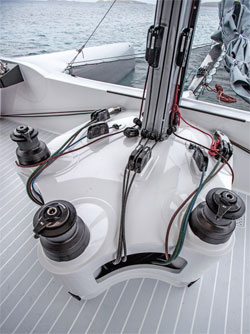

With a dream team of grand prix design talent involved, the pedigree of the Eagle 53 Class flying catamaran is extraordinary... and so is the boat
The sensation at the helm of the Eagle Class 53 is unlike anything you’ve felt on a yacht of this size. This boat feels like half of its 16m length in the light touch of its helm and the nuanced accelerations and decelerations as it sails through puffs and lulls. No feeling of inertia, just pure speed.
That is not what you expect when you board via the transom and see the spacious open-air salon where the stylish design offers not only wide spaces and comfortable seating, but also a full bar and plenty of stowage. Winches, rope clutches and lines are clustered forward in the winch island, mostly out of the way, but reachable. And a push and lift of the clever gull wing hatches on each hull reveals a simple cabin with enough amenities to be comfortable.
The roof overhead gives shelter from sun and rain, yet its lightness in design is such that you do not feel enclosed, or even remotely removed from the elements.
A closer look reveals why this is, with clear indications of the careful thought, effort and meticulous attention to detail put into this boat. Every surface is completely fair, every finish is without blemish, every radius is perfect. Not only are the custom deck fittings in exactly the right place for functionality, they have no rough edges nor misaligned fasteners nor looseness when used. Everything is perfect.
All of the principal sail control lines are led to this (below) central island and the three winches which are hydraulically powered (of course!)

Not one gram of material has been used on this boat without justification for its contribution to performance, function, safety and style. There has been very little compromise in the use of absolutely the lightest, strongest materials – carbon composites, highmodulus fibres but rarely metal – in the construction of the Eagle. Born in a shop that specialises in high-end composites, critical components in the Eagle Class 53 are carbon prepreg formed in female moulds and then baked and autoclaved.
The performance and light weight is achieved with numerous elements of this design, such as the narrow yet volume-forward, low-freeboard hulls and the cambered blister of the cabin tops that gives headroom down below where needed without too much windage drag. Another clever feature is how the loads from the rig and sails are attached: the mast on the forward crossbeam, a single composite shroud attached to the aft quarter of each hull and a carbon longeron that anchors the headstay and tack fitting for the flying Code 0. There are no attempts to rigidly cross-brace this structure to the hulls, so as you sail you watch them slightly flex in the waves ahead of you – unnerving at first until you realise how clever this is, not unlike watching aeroplane wings flex while flying in turbulent air. Flexure is part of the design.
The hard-soft hybrid wing sail allows a full-sail mode with full power to get up and go fast and a more casual wing-only mode that is actually efficient enough to propel the boat at close to wind speed in as little as 12 knots. With the high-clew jib on a furler and hydraulics driving the boat’s three winches, sail handling is thus very simple and ideally suited to short-handed sailing.
At the time of our trial sail the foil control systems were still being tested and the wind was a bit too light to pop up free of the water. Project manager Tommy Gonzalez also admits wanting to take baby steps to fully understand the effects of the C-foil and the trim angles controlled by the T-foils on the rudder blades so that mistakes are not made, as with previous foiling designs. Safety first, then speed.
The high level of sophistication in all aspects of design and fabrication is a clear indication that this level of craftsmanship did not come without a serious team effort. Tommy Gonzalez, Wolfgang Chamberlain, Manu Armenanzas and his crew at Fast Forward Composites worked closely for over a year with designer Paul Bieker, Andres Saur and Eric Jolley at Bieker Boats, composites engineer Will Brooks, multihull legend Randy Smyth, stylist Eric Goffrier and other experts in foil and aero design to fulfil this vision of creating the most modern high-performance multihull on the market today.
Click here for more information on Fast Forward Composites »
We invite you to read on and find out for yourself why Seahorse is the most highly-rated source in the world for anyone who is serious about their racing.
To read on simply SIGN up NOW
Take advantage of our very best subscription offer or order a single copy of this issue of Seahorse.
Online at:
www.seahorse.co.uk/shop and use the code TECH20
Or for iPad simply download the Seahorse App at the iTunes store


